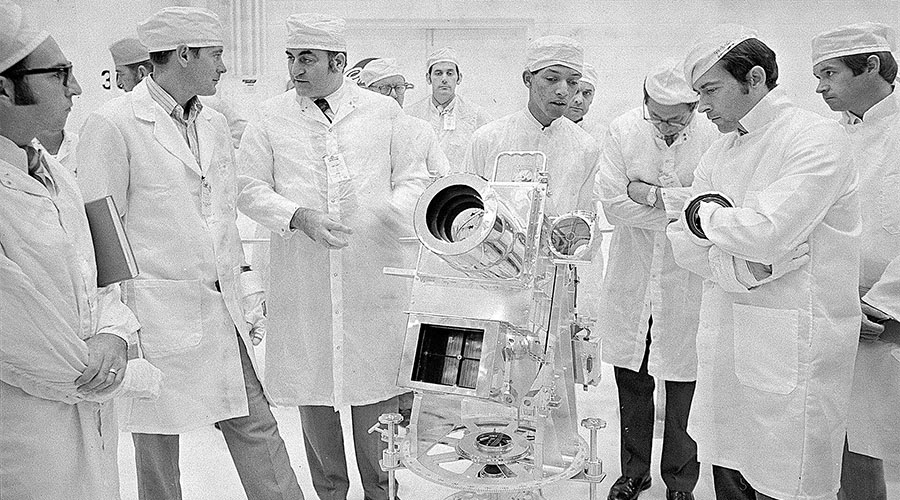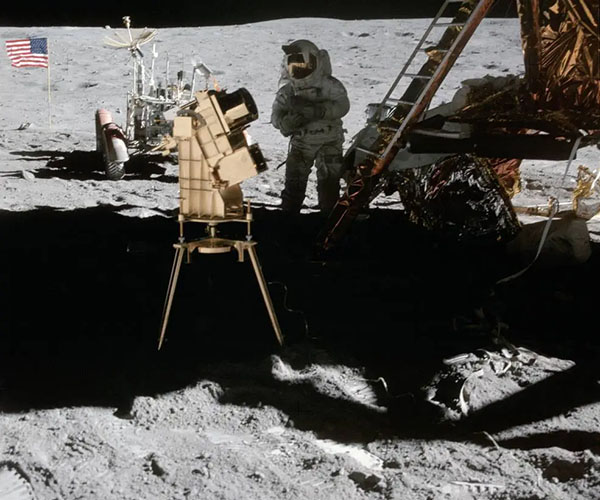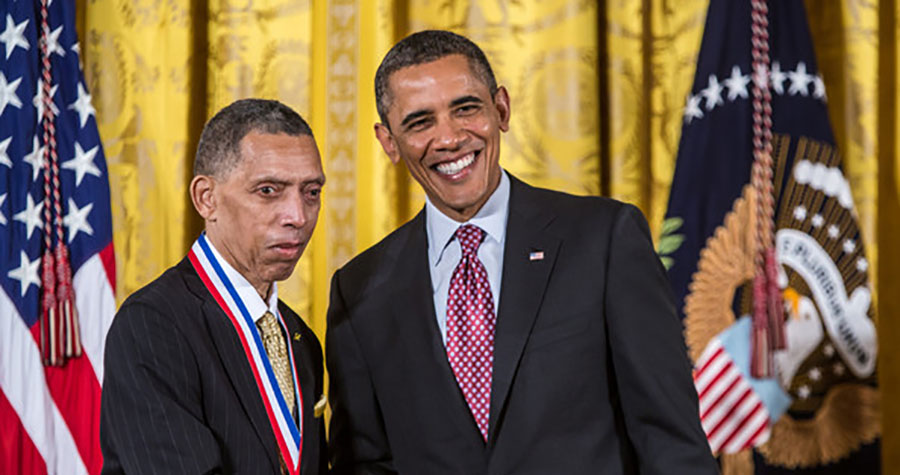April 20, 1972: George Carruthers’ Ultraviolet Telescope Lands on the Moon
His invention was the first telescope set up on another planetary body.
By Kendra Redmond | March 15, 2024

Credit: NASA
George Carruthers, center, discusses the ultraviolet telescopic device with Apollo 16 Commander John Young, right.
In the early 1950s, astronomy was an Earth-bound affair. Telescopes on the ground peered up through Earth’s atmosphere; the first satellite launch was years away. So when a teenager named George Carruthers approached astronomers at the Adler Planetarium and asked them about conducting astronomy from space, they scoffed at the idea.
But Carruthers was right: Space-based astronomy was around the corner. Two decades later, a pair of astronauts assembled Carruthers’ own invention — a gold-plated telescope for ultraviolet imaging — on the surface of the moon.
As a child, Carruthers first became interested in space flight from a comic book featuring the science-fiction hero Buck Rogers. A love for astronomy soon followed, sparked first by an encyclopedia entry and then a Collier magazine series called “Man Will Conquer Space Soon!"
Carruthers' didn’t exactly fit in at his rural Ohio elementary school. “A lot of both my teachers and [the] students thought my interest in astronomy was strange,” he recalled in a 1992 interview with the American Institute of Physics. He was also one of just a handful of Black students.
But Carruthers’ father — a civil engineer — encouraged his son’s interest in math and science. He died when Carruthers was 12, and the family moved in with relatives in Chicago. In the city, Carruthers could more easily feed his curiosity; the elevated train took him right to the Adler Planetarium. “The people who were interested in astronomy weren't interested in space flight and vice versa,” he recalled. “When I talked about space flight, [the astronomers at Adler] told me that was nonsense, because that was before any space flight mission had ever taken place.”
Undeterred, Carruthers immersed himself in the science of rocketry and astronomy during high school and college and headed to the University of Illinois, Urbana-Champaign, for graduate school in aeronautical and astronautical engineering. As part of his thesis, Carruthers studied the spectra of atomic nitrogen recombination in visible light.
By the time Carruthers earned his doctorate in 1964, the space race between the United States and the Soviet Union was in full swing, with NASA gearing up for the first American spacewalk. Carruthers clinched a postdoctoral position — and eventually full staff role — in Washington, D.C., in the Naval Research Laboratory’s Space Science Division, led by physicist and astronomer Herbert Friedman.
While NASA concentrated on space flight, researchers in Friedman’s division were using sounding rockets to probe the structure of the Earth’s upper atmosphere, the Sun, and newly discovered ultraviolet and x-ray emitting cosmic sources. It was pioneering work. Getting above Earth’s atmosphere was key to seeing the universe in short wavelengths, and it had only become possible with rocket payload experiments in the late 1940s. By the 1960s, the technology for these experiments had improved significantly. With the right resources, Friedman wrote in 1963, “major advances in astrophysics can be achieved in the immediate future through the use of observatories in space.”
In his new position, Carruthers applied his experience with spectroscopic techniques to astronomy. Methods for collecting spectroscopic data at the time were prone to quantum efficiency losses and wavelength cutoffs, or they required scanning Geiger counters. In the search for a solution, Carruthers had read about new electronic imaging devices that converted electromagnetic radiation images into electron images. They were efficient, more sensitive than traditional ultraviolet film, maintained the integrity of the image, and captured an entire spectrum in a single exposure. With only journal articles as his guide, Carruthers built and patented a robust image converter of his own. In its first rocket experiment, his device captured far ultraviolet signatures of molecular hydrogen in interstellar space, confirming its existence.
In 1969 — the year that the Apollo 11 mission put people on the moon for the first time — NASA put out a call for experiments that astronauts could conduct on future landings. Independently, Carruthers and the astronomer Thornton Page proposed doing ultraviolet imaging of Earth and space from the surface of the moon. At NASA’s suggestion, the two joined forces, Carruthers as principal investigator and chief engineer and Page as science lead, and the project received approval. The planned camera would be “the most advanced light recording system in the world,” wrote NASA project scientist Martin W. Molloy in a 1970 memo. Its data could shed light on the structure of our galaxy, the composition of the solar wind, and more.
In two short years, Carruthers and Page designed the Far Ultraviolet Camera/Spectrograph. The device was built to survive a launch into space, function on the moon, be controlled by astronauts in full gear, and reveal unknown ultraviolet emissions.
It was packed into a spacecraft, and on April 20, 1972, Apollo 16 and its crew landed with it on the moon. Astronaut John Young set up the 50-pound telescope in the Descartes Highlands. He and Charles Duke spent three days on the lunar surface, collecting rock and soil samples, performing experiments, and manually pointing Carruthers’ telescope at Earth and space targets.
The film they brought back contained nearly 200 images, among them the first image of Earth from a distance in ultraviolet light, and images of Earth’s polar auroras and tropical airglow belt. A surprising and important finding was that hydrogen extends far above Earth’s atmosphere, according to Carruthers. Other images revealed stars and nebulas hidden in visible light and details about the composition and structure of interstellar space.

Credit: NASA
Apollo 16 astronaut John Young used Carruthers’ ultraviolet telescope to photograph Earth and space from the moon. It was the first telescope used on the surface of another planetary body.
The project’s success solidified Carruthers as a visionary engineer, inventor, and astronomer. He continued working at the Naval Research Lab for nearly forty years before retiring in 2002 as senior astrophysicist, and then went on to teach Earth and space science at Howard University. He became a dedicated mentor for students, including high schoolers, and young Black scientists.

Credit: Charles Dharapak / photo retrieved from Naval Research Laboratory
In 2012, President Barack Obama awarded Carruthers the 2012 National Medal of Technology and Innovation.
Carruthers died in 2020. In 2022, NASA renamed its GLIDE mission — a space mission to observe Earth’s atmosphere in ultraviolet light — the Carruthers Geocorona Observatory, slated to launch in 2025.
And his contribution to Apollo 16 still sits in the lunar highlands. “If an alien life form happens to land on our moon a billion years from now,” write Richard Paul and Steven Moss in We Could Not Fail: The First African Americans in the Space Program, the visitors would spot Carruthers’ invention: “Coated in pure gold, it stands on three legs and stares out blankly at the infinite void: the first telescope ever set up on another planetary body.”
Kendra Redmond is a writer based in Minnesota.
©1995 - 2024, AMERICAN PHYSICAL SOCIETY
APS encourages the redistribution of the materials included in this newspaper provided that attribution to the source is noted and the materials are not truncated or changed.
Editor: Taryn MacKinney
April 2024 (Volume 33, Number 3)
Articles in this Issue

